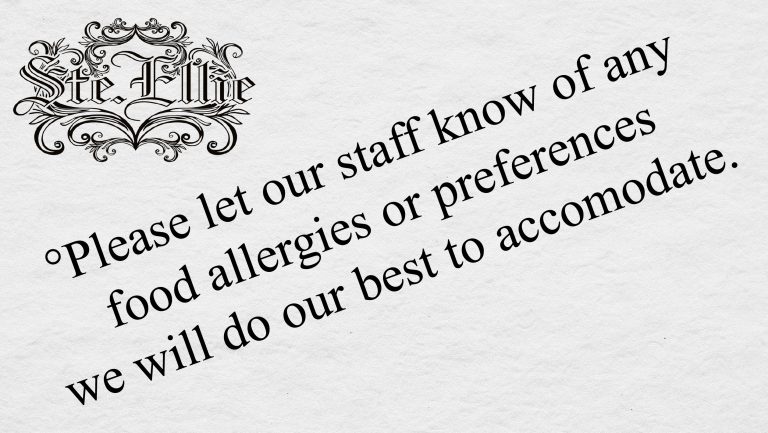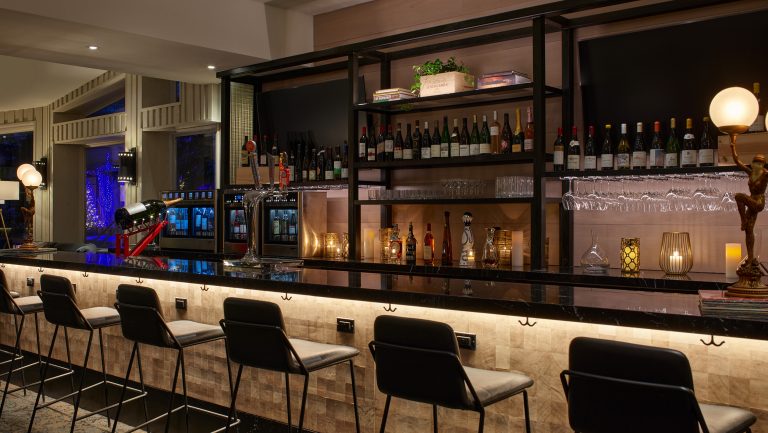In an era when customers are more and more attuned to their allergies, aversions, and dietary restrictions, and as bartenders are using evermore exotic ingredients in their drinks, it may be time to consider adding warning labels to the cocktail menu. Here, SevenFifty Daily examines some bars’ philosophies on the matter and the labeling schemes they’re employing to warn customers about potential dangers in their drinks.
“I don’t know anybody who has worked in the industry for a long time without seeing at least one person have an allergic reaction to something, and it’s scary,” says Morgan Schick, the creative director for Bon Vivants, the company that owns San Francisco bars Trick Dog and the forthcoming Bon Voyage! and that developed the bar program for the San Francisco outpost of Proper Hotels.
A couple of years ago, Schick instituted a thorough labeling program for all the bar menus Bon Vivants oversees. He’d listed potential allergens as ingredients on earlier menus, but the company upped its game on designing a drink list at Trick Dog inspired by a Chinese restaurant. “We had a couple of nut drinks on it—that’s why we did it,” Schick says. “One of them had almond in the bitters; one had a walnut-infused fernet. And one had some sneaky dairy in it.”

Don’t miss the latest drinks industry news and insights. Sign up for our award-winning newsletters and get insider intel, resources, and trends delivered to your inbox every week.
The menu featured symbols, like a flame for spicy drinks, similar to the icons you’d see on a menu at a Chinese restaurant. Schmick added additional symbols, including a cow for dairy. “It was so easy to do it from the design standpoint,” says Schick, “and then we just said, We should really continue to do this; this is smarter. Now it seems really important to keep doing it. It’s such a little thing to add to the menu to save somebody; maybe they don’t know what orgeat is, or maybe they just didn’t read the menu properly.”
Schick says that Bon Vivants doesn’t label obvious things, like gluten in beer, but it does label nonobvious items, such as a gluten-containing ingredient in a cocktail, or a drink that’s not 100 percent vegetarian.
The labeling scheme Schick and his colleagues chose for Trick Dog’s Fall 2017 menu was an asterisk at the end of the cocktail listing with an explainer directly below the description—for example, “Contains gluten. Vegetarian, dairy-free without garnish.” This explainer lists what’s in the drink that can’t be substituted (gluten, from cracker-infused rum), and what can be substituted or removed, in this case the garnish.

Trick Dog’s menu is known for its oddball ingredients, like “everything bagel” spices, and cream cheese‒washed gin, but most menus are not so wild, so few warnings may be needed. At San Francisco’s touristy tiki palace the Tonga Room, falernum and orgeat, both of which contain almonds, are the only potential allergens that are labeled, with an asterisk next to the individual ingredient on the drinks list and a single note at the bottom of the menu: “Product contains nuts.”
Bar Clacson in Los Angeles also stars individual ingredients that may pose a risk with a large warning at the bottom of the page that states “Contains ingredients that may be harmful to individuals with nut allergies!”
At Bresca in Washington, D.C., the asterisk on the one warning-worthy cocktail follows the drink name rather than the potential allergen, with a shellfish warning below.
Bar Fiori, in the Langham Place Hotel in New York City, labels cocktails with nut-containing ingredients beside the drinks’ names. One example is a drink listed as “Malted Flip* contains nuts,” with the drink’s ingredients on the second line. The menu in the dining room, however, doesn’t have the warning, and it’s up to the table captain to inform diners of potential allergens.
At Saint Ellie in Denver, potential allergens are starred with an asterisk next to the ingredient name, but warnings appear in different places on the menu. Orgeat is described thus in a glossary section: “Orgeat: A syrup flavored with Almonds; if you’re allergic to Almonds, no orgeat for you.”

For other potential food and drink allergens, a warning is listed at the bottom of the menu: “The Fine Print. These items are cooked to order and may be served raw or undercooked. Consuming raw or undercooked meats, poultry, seafood, shellfish, or eggs may increase your risk of food-borne illness. Since we’re doling out advice here: wash your hands. Take the stairs occasionally. Eat your vegetables. Tell your friends you love them. Tip gratuitously. Keep on lighting farts and breaking hearts. We love you Denver. Also: Roll Tide.”
It makes you glad you looked.
Besides nuts and egg whites, one other starred ingredient stands out on the menu: hibiscus. “Our current philosophy is to asterisk anything that is a potential dietary [allergen], of a hidden or obvious nature, or any common or commonly cross-contaminating allergens,” says Kevin Burke, who until recently was Saint Ellie’s beverage director. “Hibiscus, specifically, is commonly grown and co-cropped with peanuts, and anyone with a severe peanut allergy should be aware. I would rather be safe and over-disclose rather than deal with an EpiPen situation.”
While some municipalities require labeling of uncooked eggs, meat, and seafood on menus, very little labeling is required in the United States as compared with other countries. In European Union countries, it’s a different story. According to Paul Matthew, director of The Hide Bar in London, the E.U.’s Food Standards Agency lists 14 allergens that must be disclosed to consumers if they are present in served food or drinks. “They don’t have to be listed on the menu,” Matthew says. “The information just has to be available to anyone asking.” The list includes expected items—peanuts, eggs, and nuts—but also specifies allergens we don’t think much about in the U.S., including mustard, sesame, and celery.
On an earlier menu at The Hide Bar, Matthew listed all the potential allergens with a key at the bottom of the menu, but he received feedback that it was too cumbersome for customers to absorb. He has since defaulted to printing the line “Please ask for allergen information,” as is the common practice at most London bars.
At The Aviary, with locations in Chicago and New York, allergies and dietary warnings are fielded by the waitstaff and added to one’s guest ticket. Guests are asked if they have any dietary restrictions or allergies, and servers are trained to follow up with additional questions, such as “Is this an allergy or an aversion?” and to ask about related allergies, such as truffles for those who have mushroom allergies, or whether coconuts are included in someone’s nut allergy. (Servers have a four-page document of allergen information, with follow-up questions to work from.) Then its up to the bartenders and chefs to avoid these ingredients.
The tricky part of the labeling game is that we just don’t know what’s in the secret recipes of many products, like gin, liqueurs, and bitters. A few brands, including Bittermens, list known allergens on their websites, but this is the exception rather than the rule. Chartreuse supposedly has 130 ingredients, yet we aren’t told any of them. So for now, the best that bars can do to keep customers safe is to label all potential allergens of which they’re aware.

Dispatch
Sign up for our award-winning newsletter
Don’t miss the latest drinks industry news and insights—delivered to your inbox every week.
Camper English is an international cocktails and spirits writer, speaker, and consultant, with a focus on the science of booze and big clear ice. His work has appeared in Popular Science, Cook’s Science, Whisky Advocate, Saveur, Details, the San Francisco Chronicle, and many other publications.








